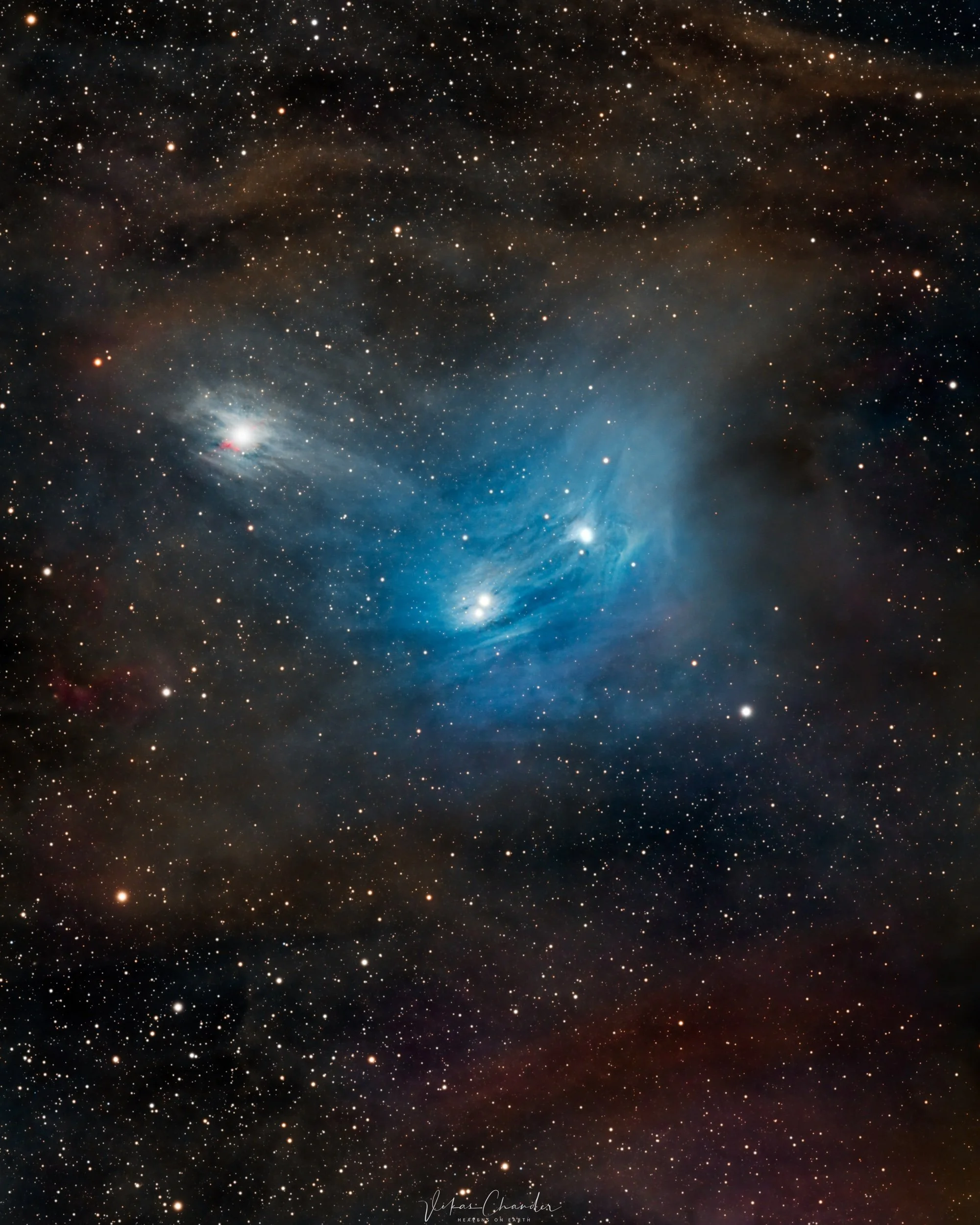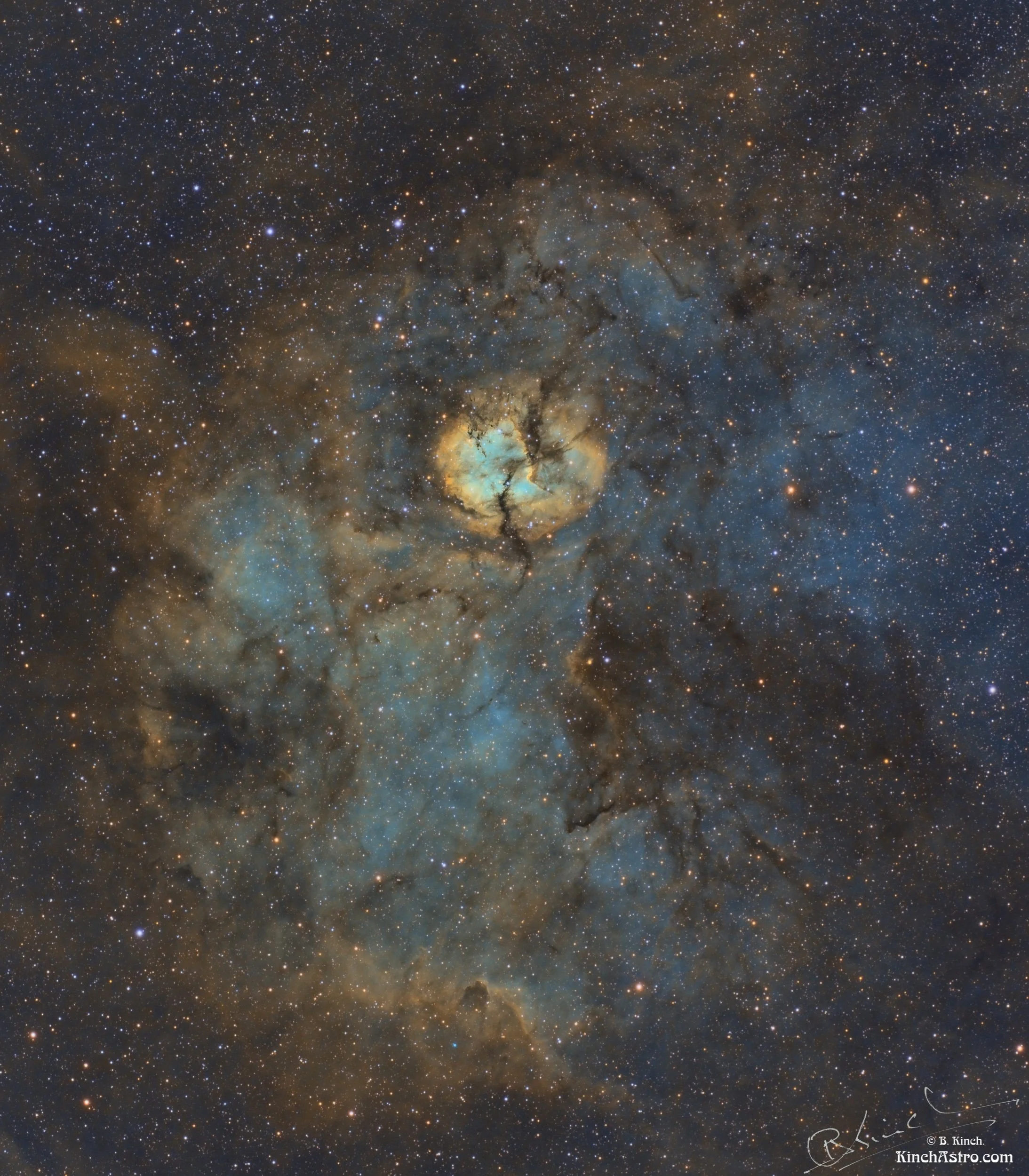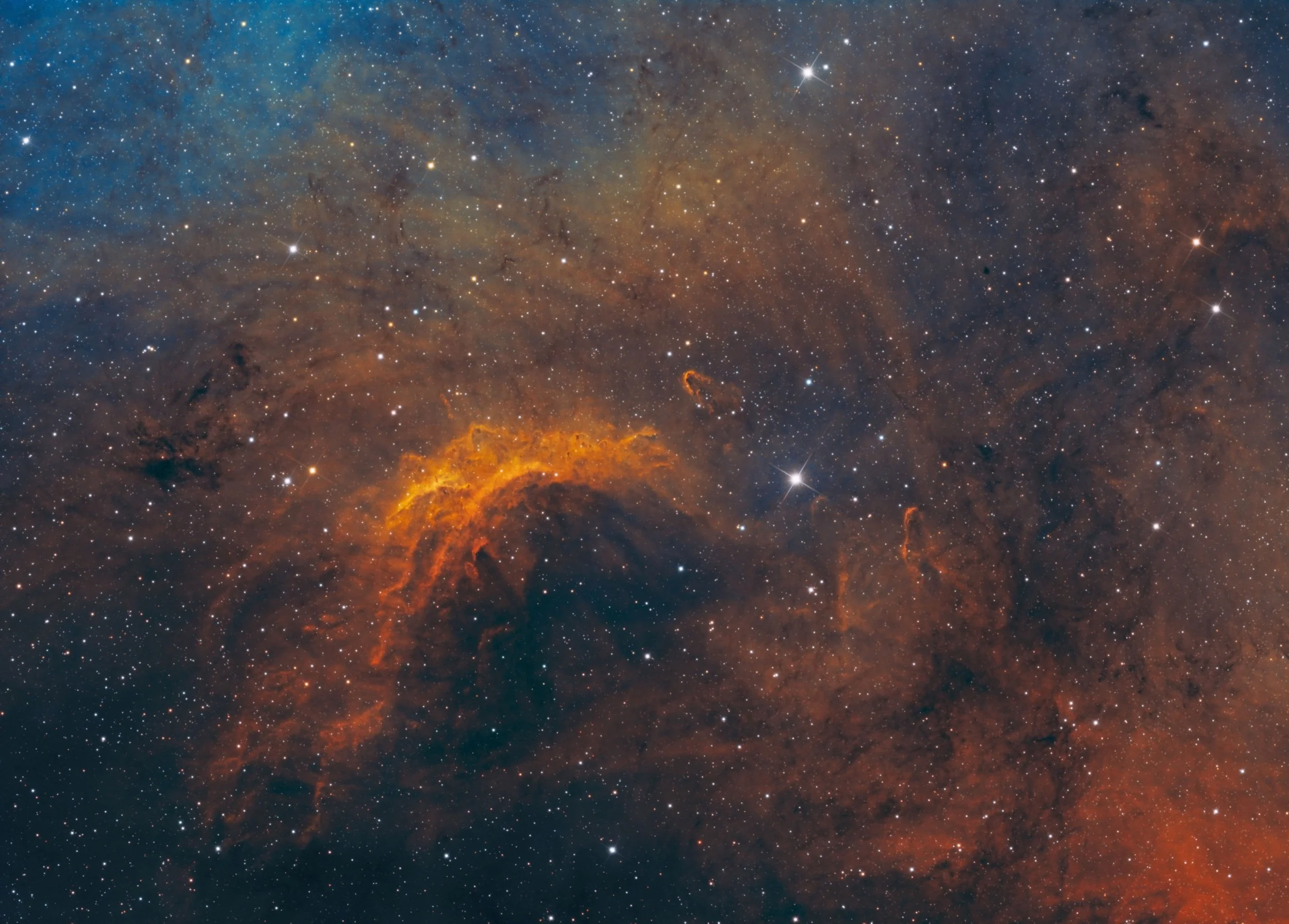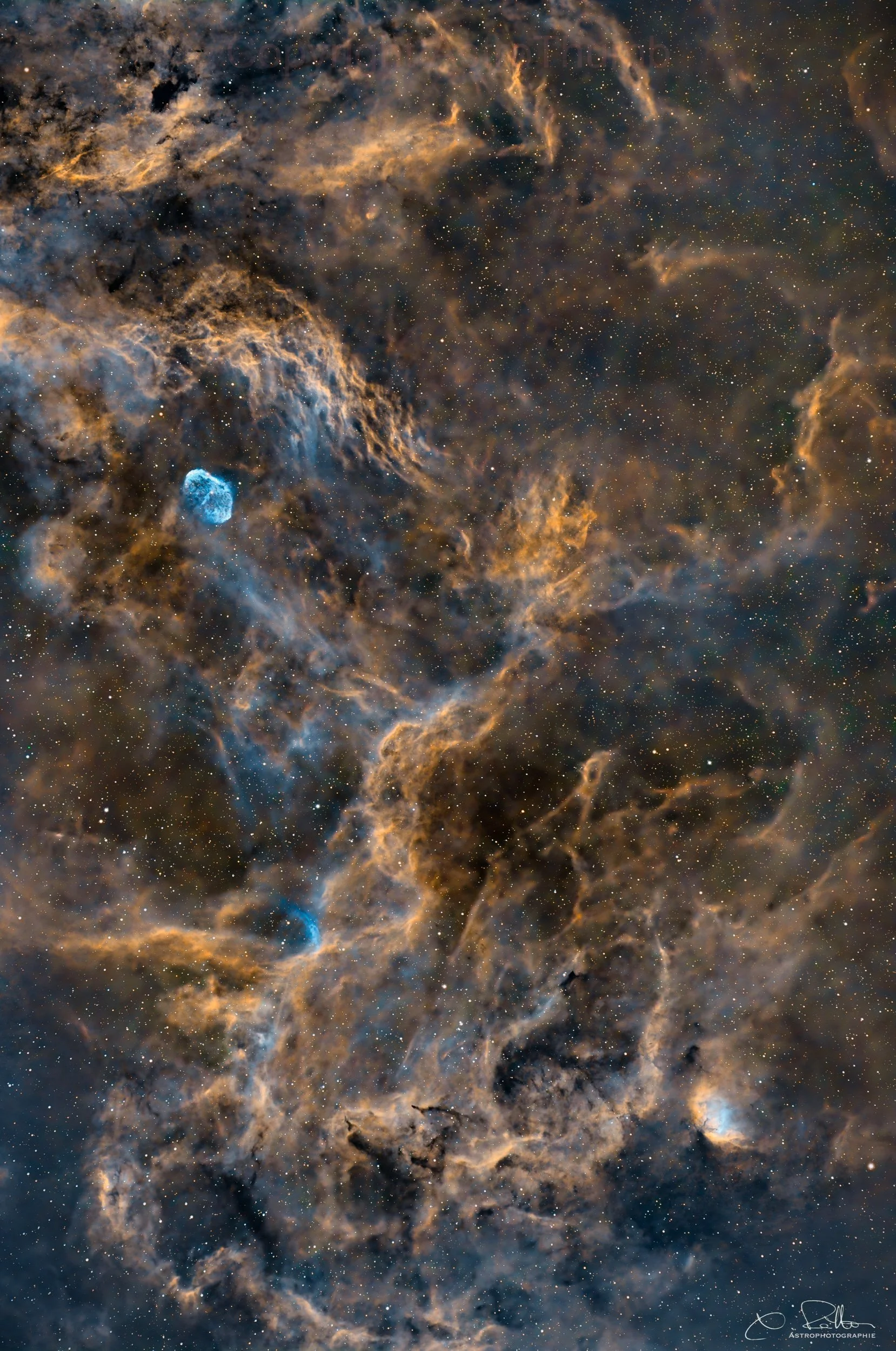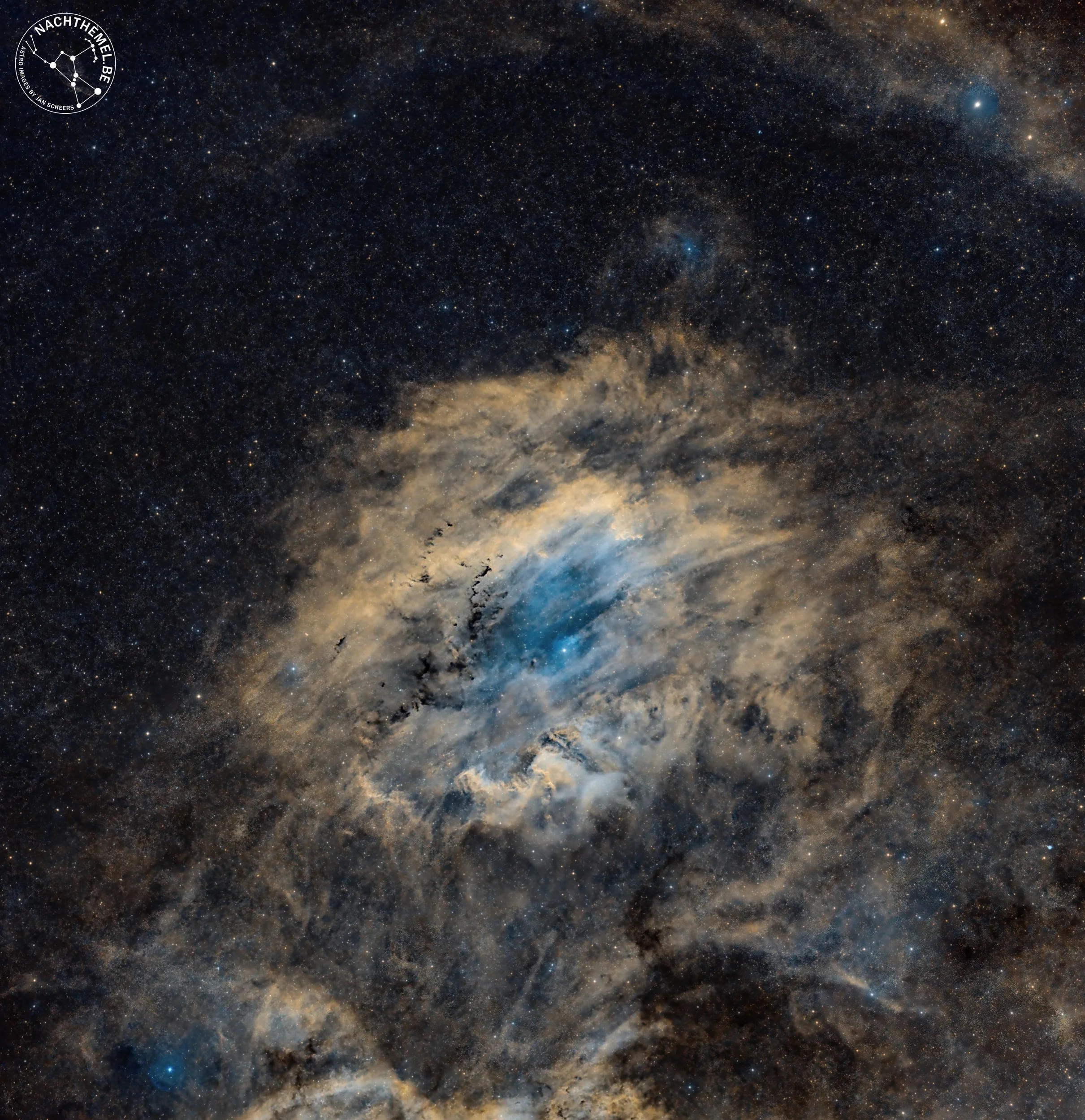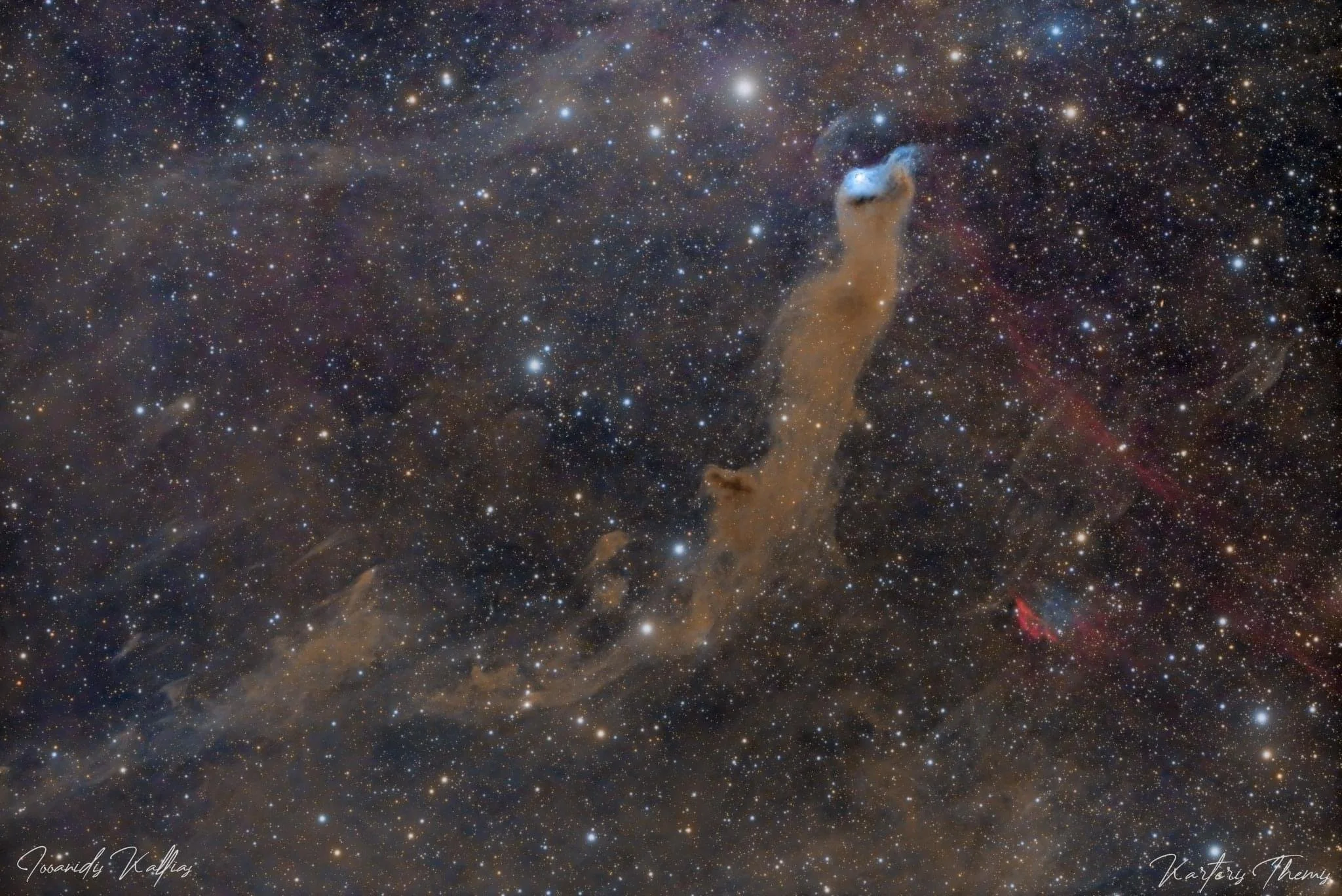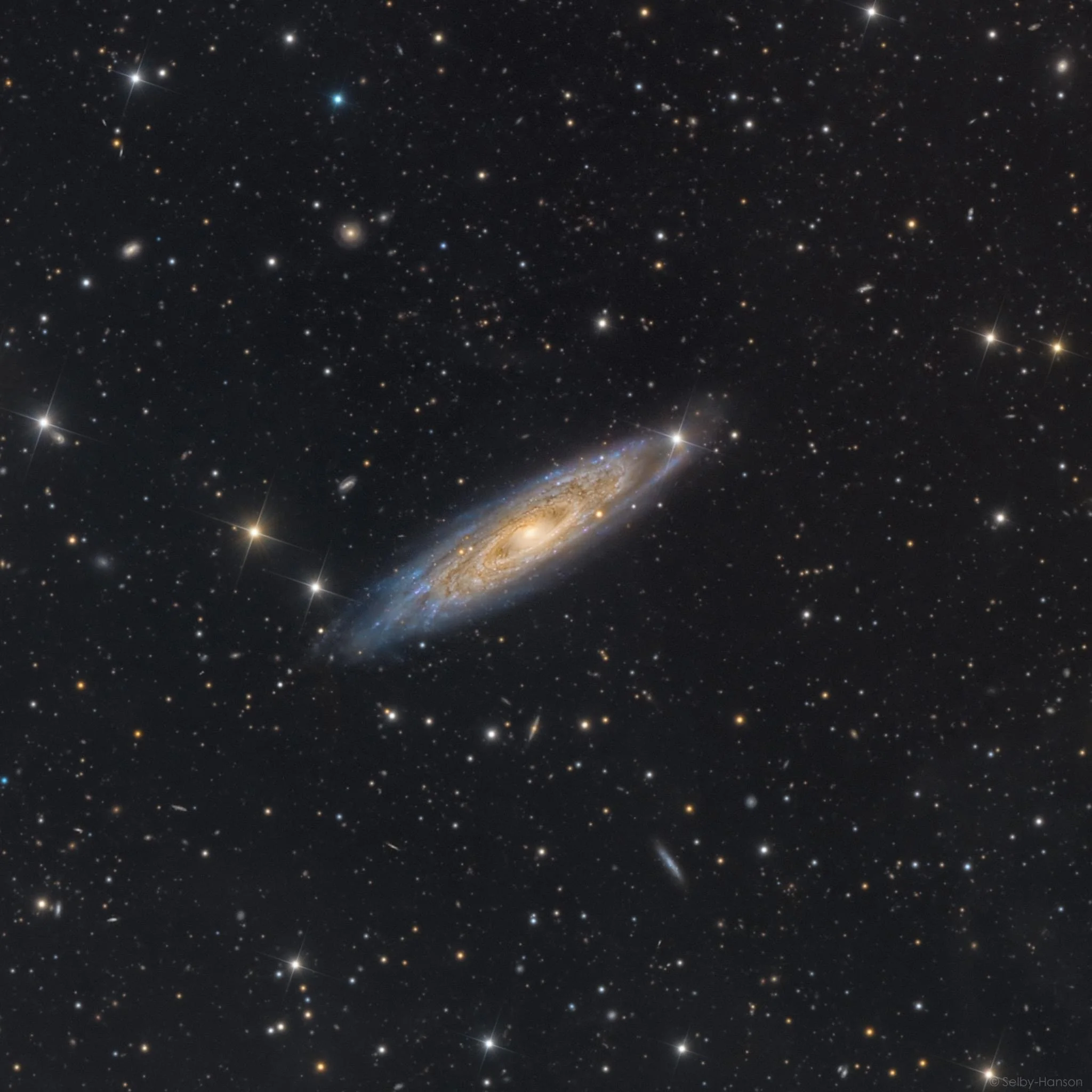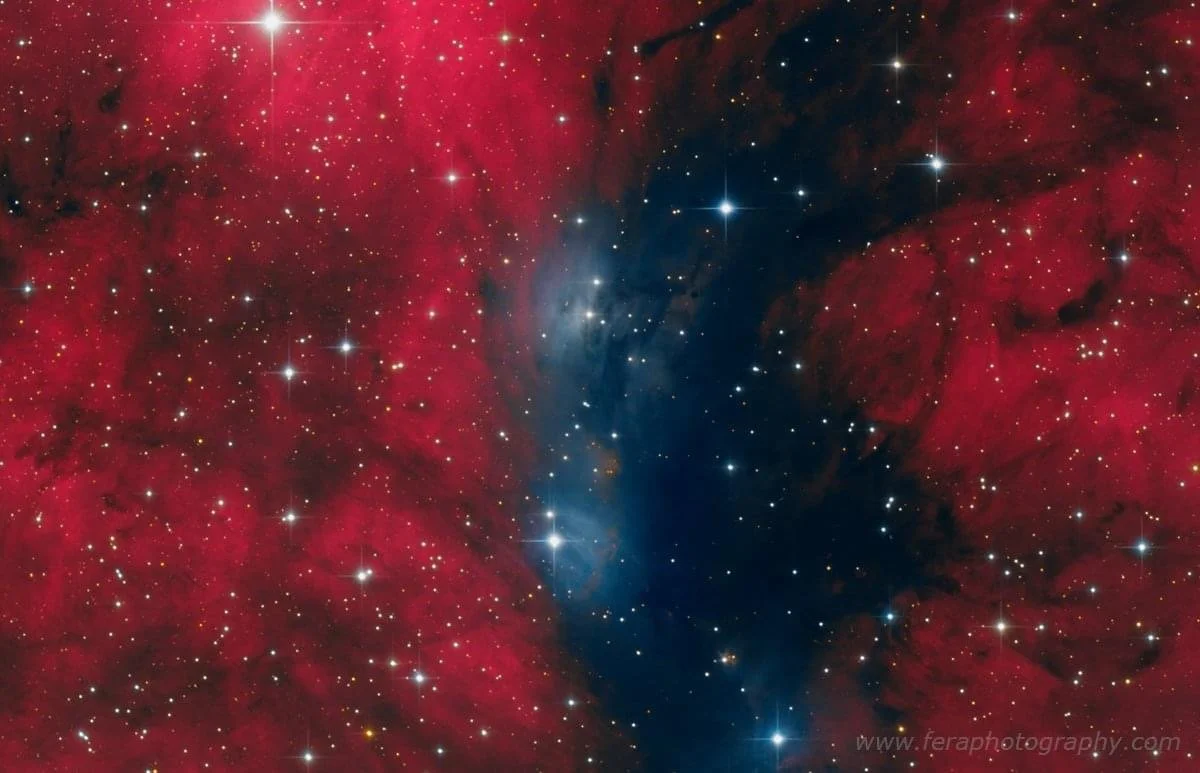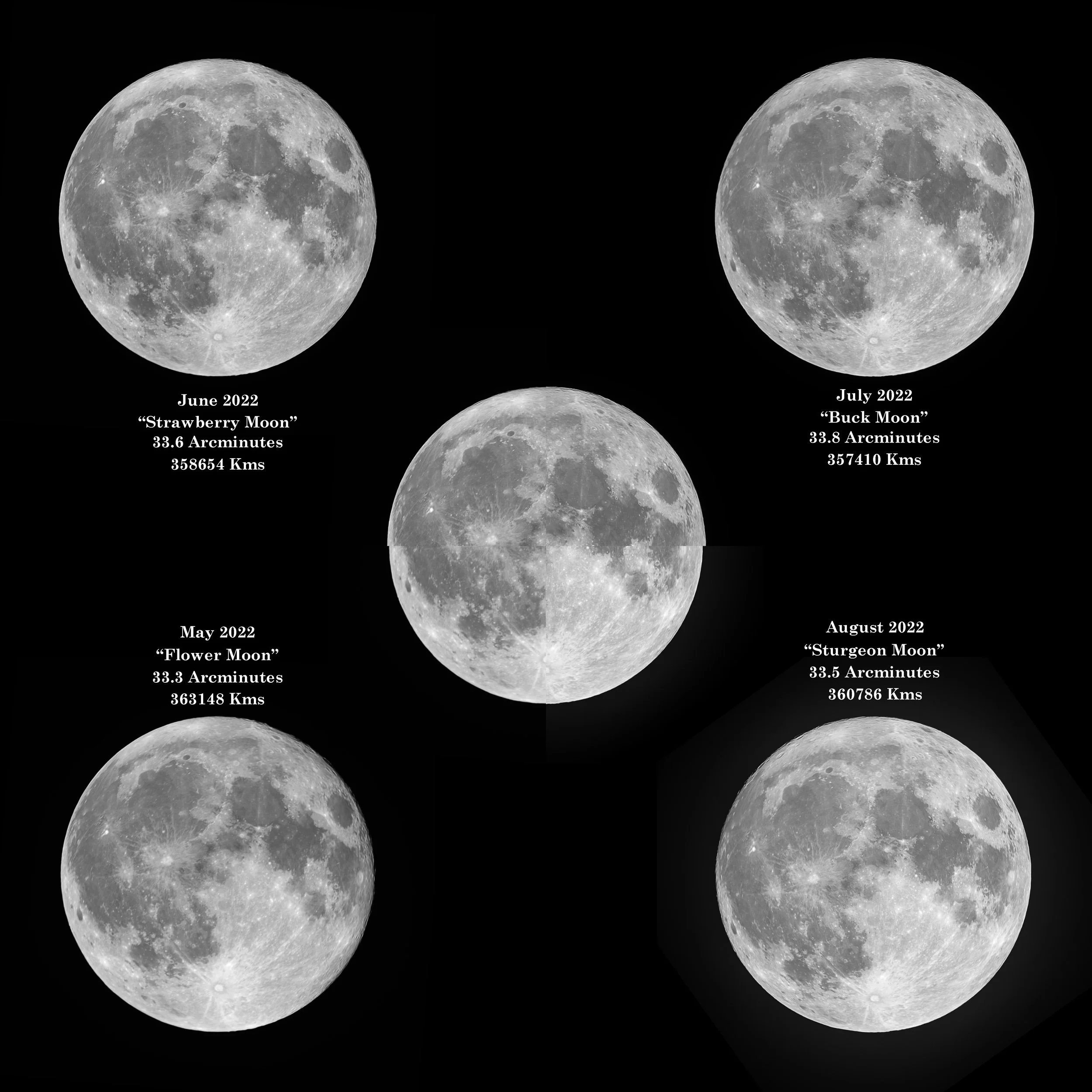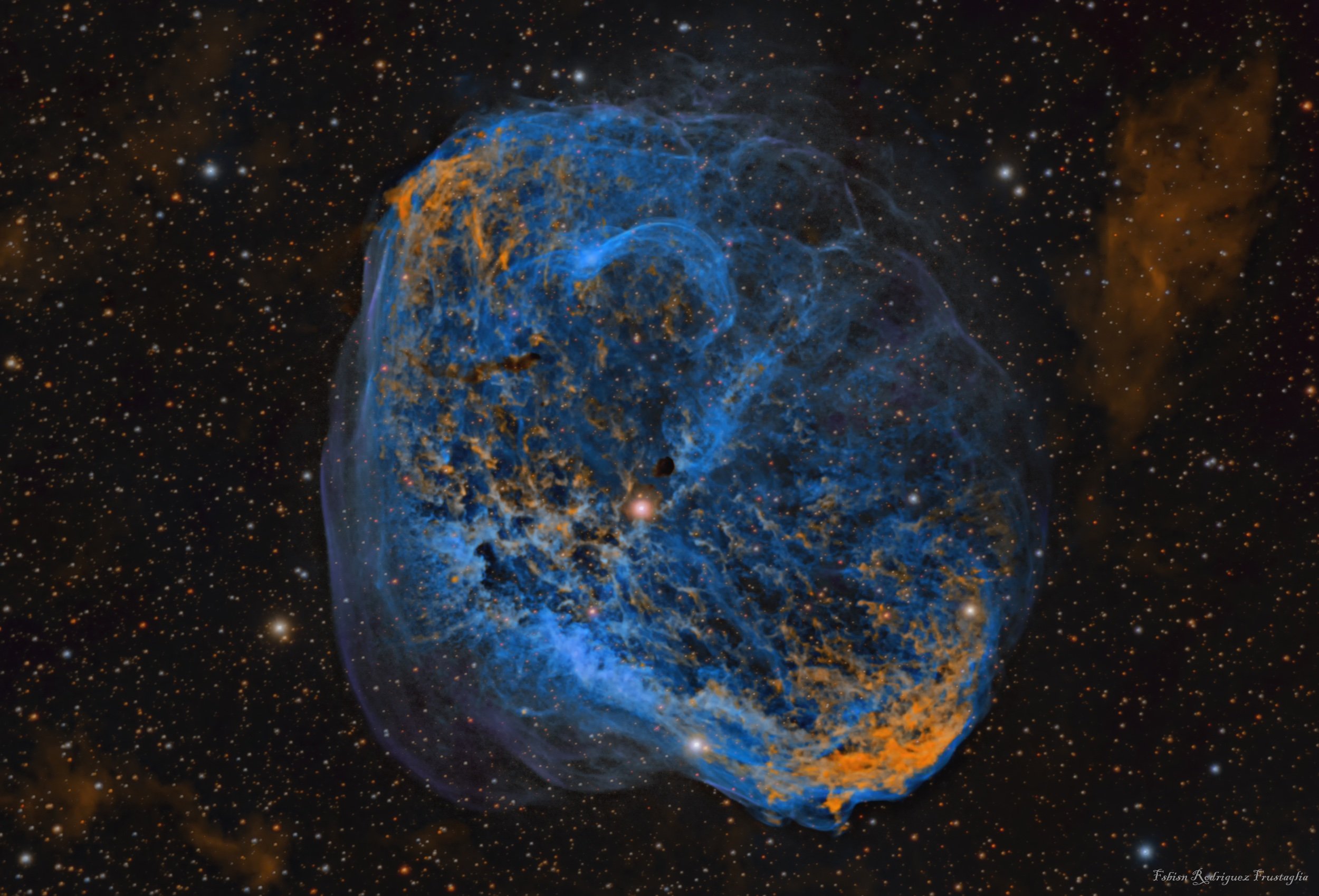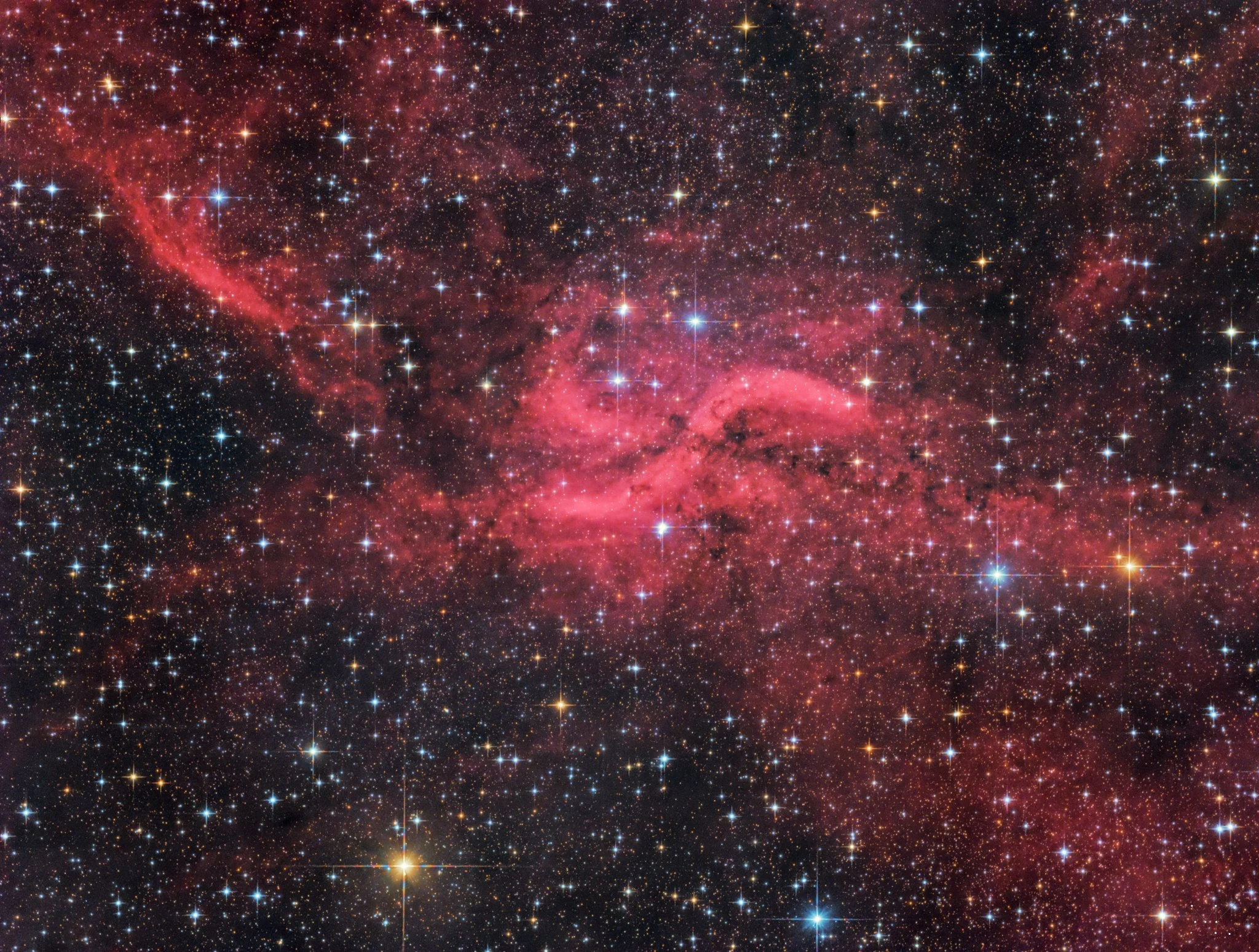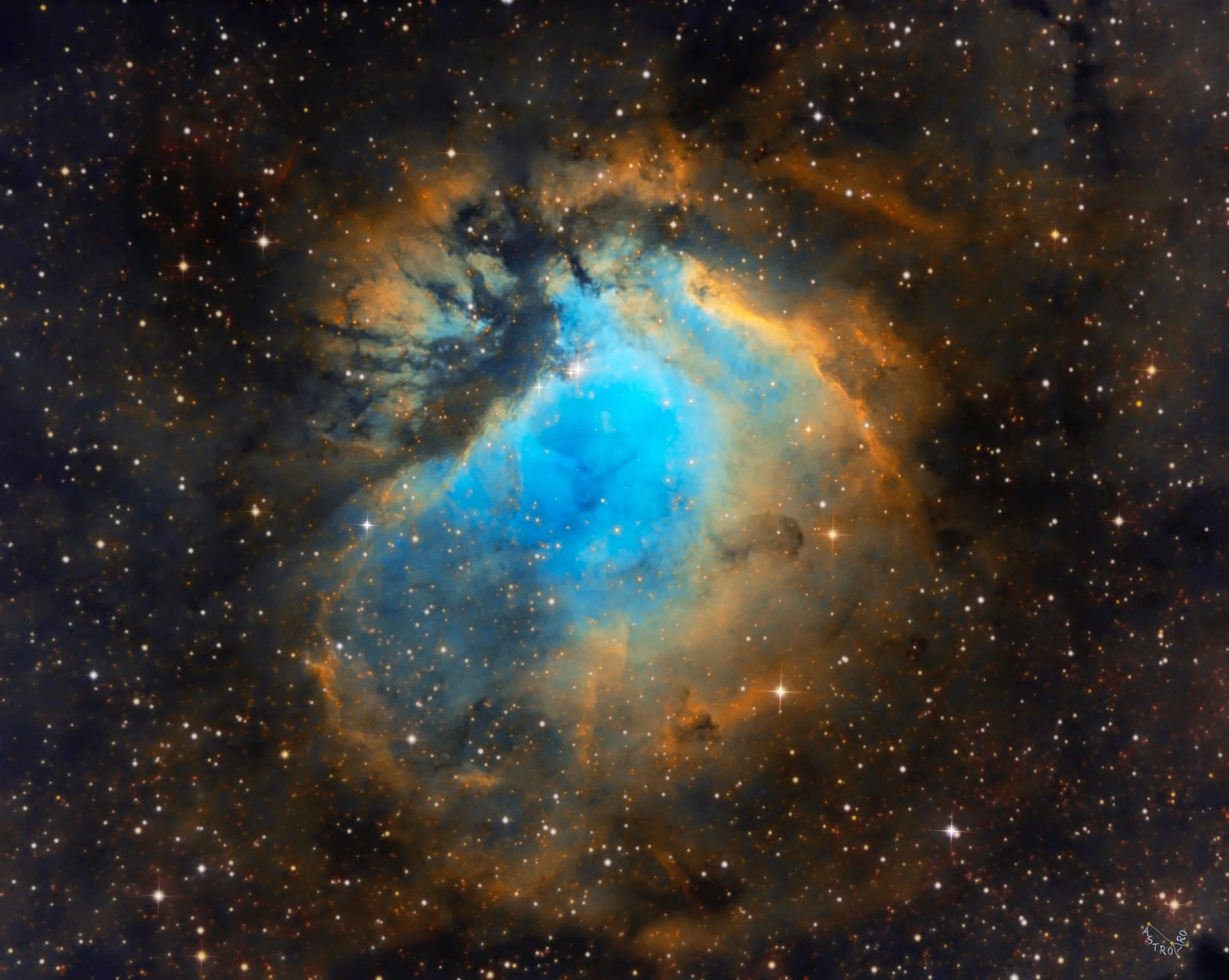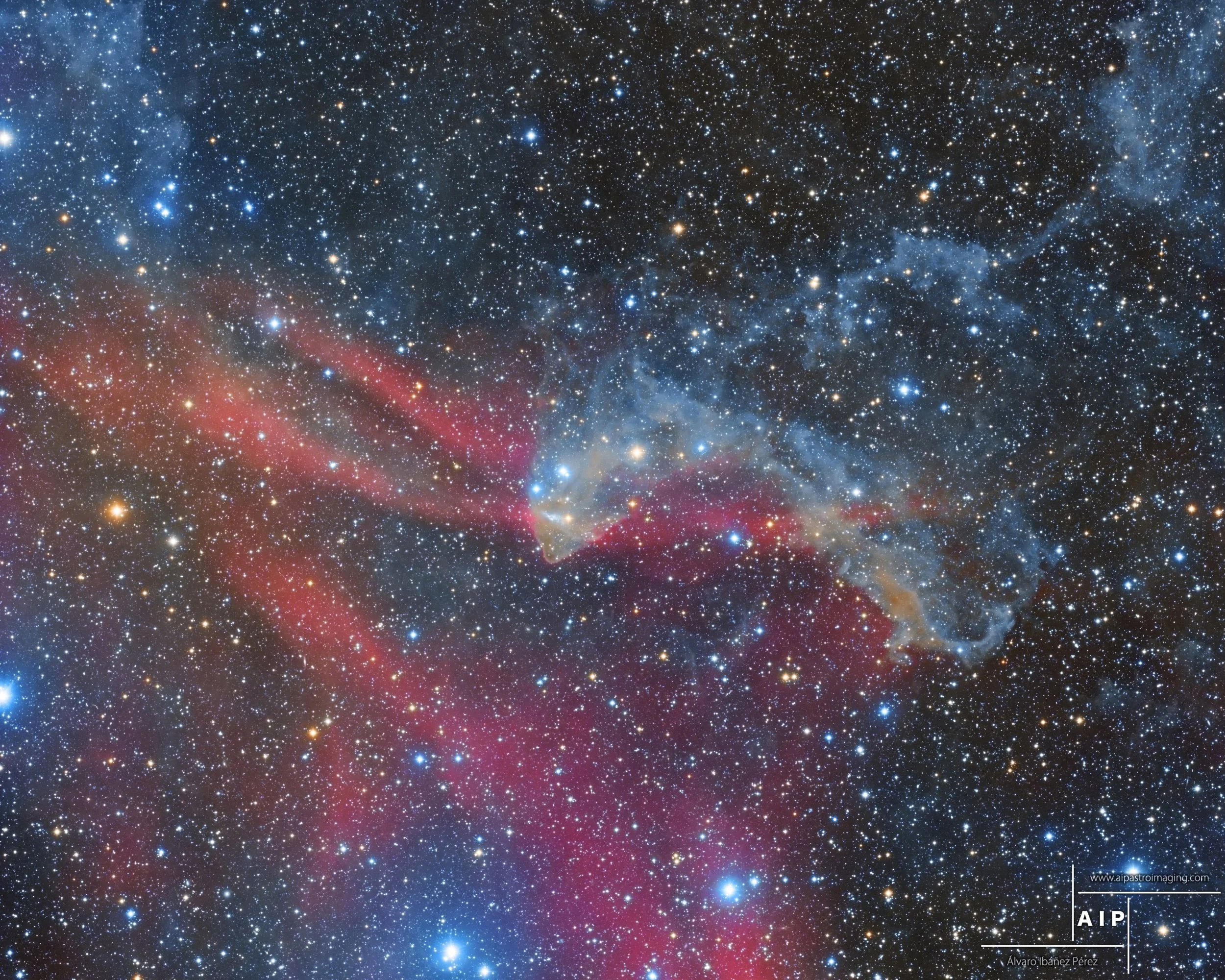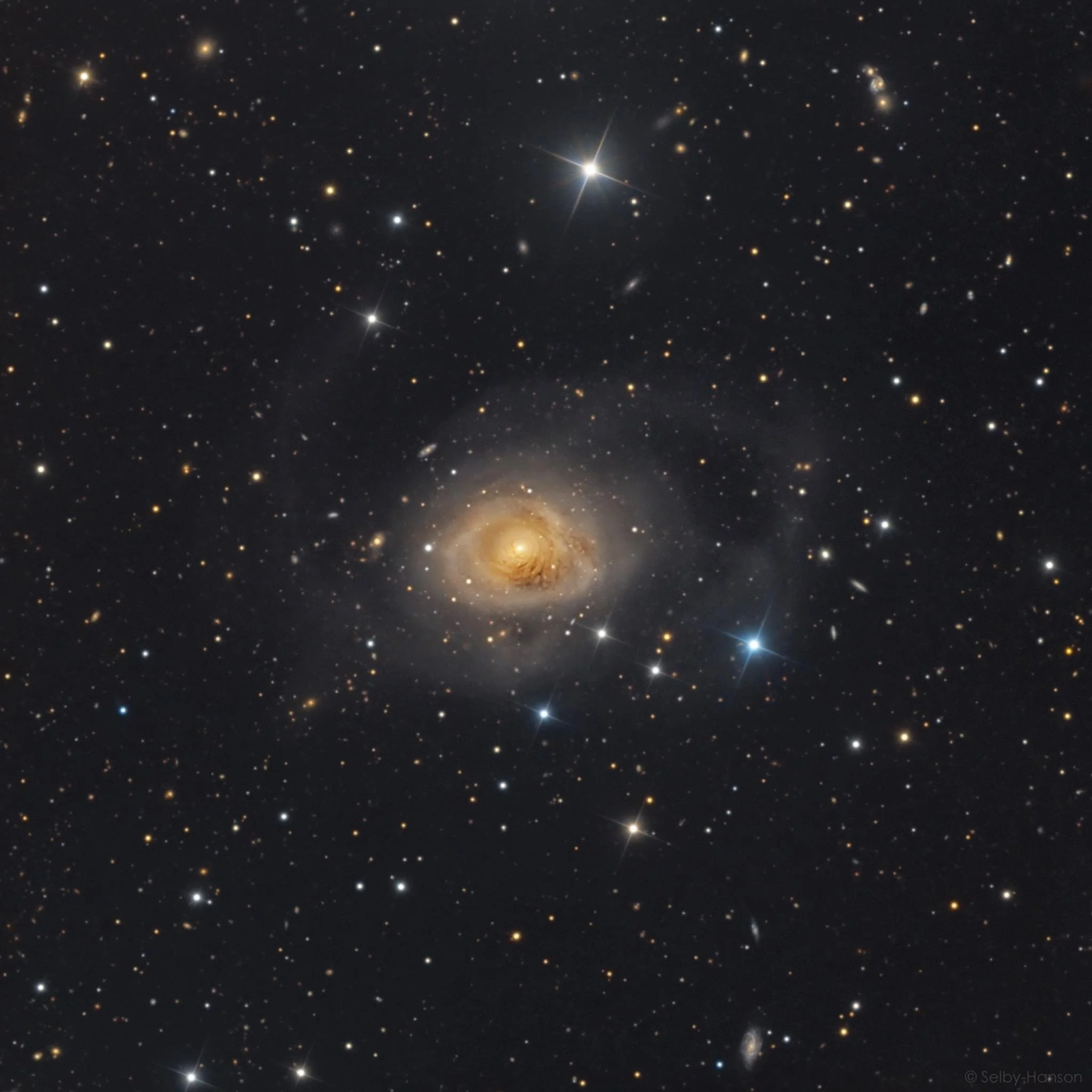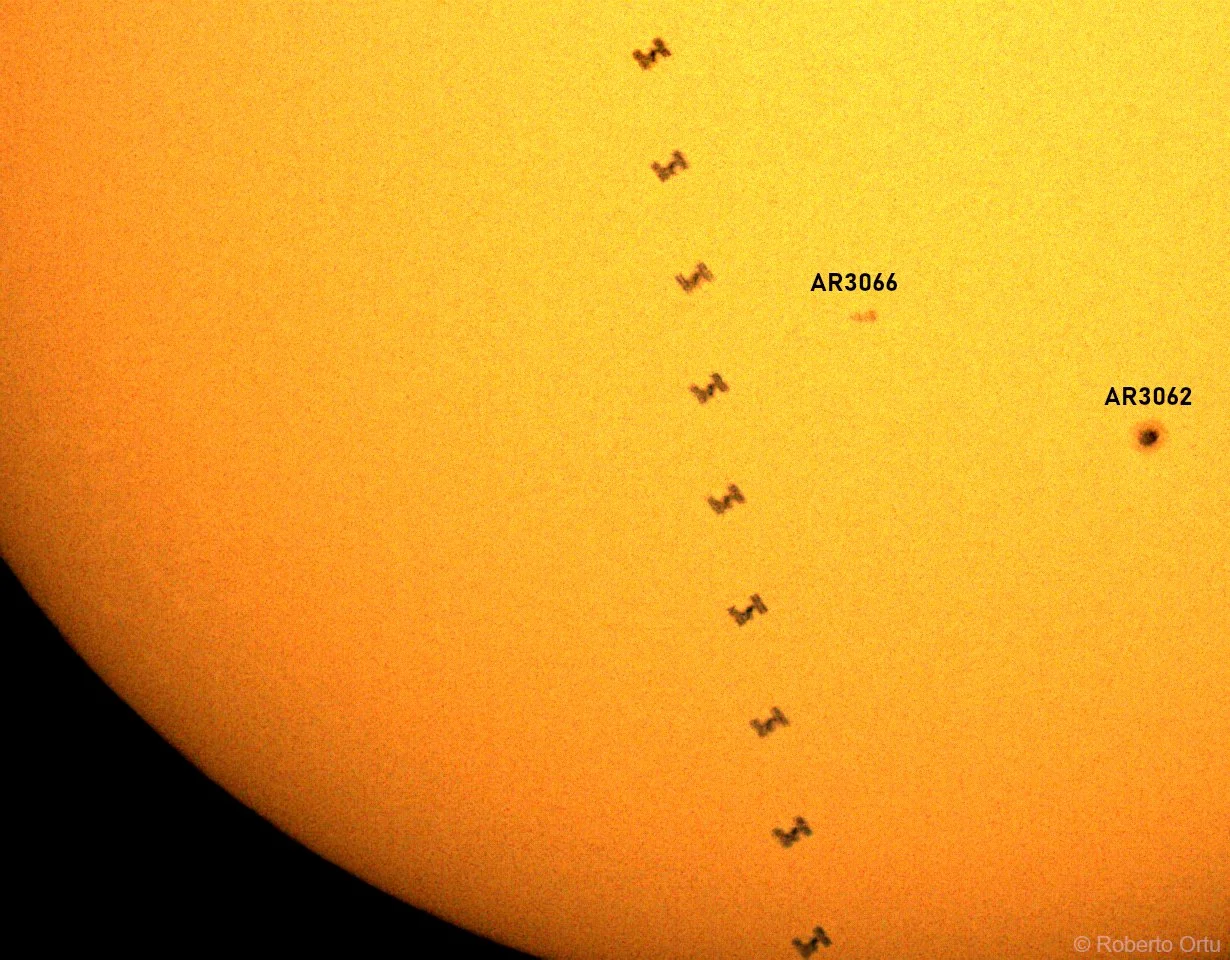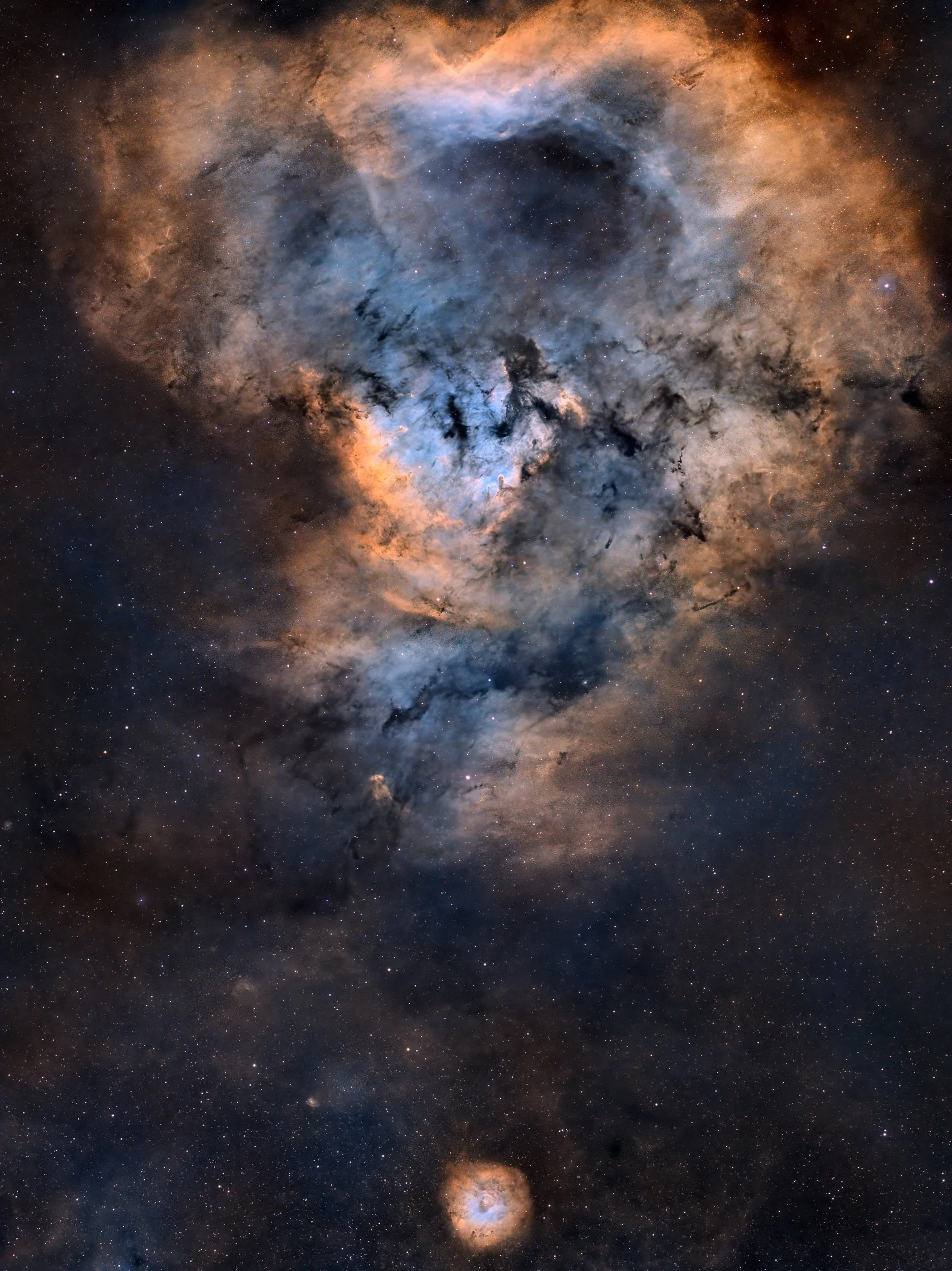
AAPOD2 Image Archives
vdB 102
Image Description and Details : This is an image of vdB102, a reflection nebula, located in the northern part of the constellation of Scorpius, north of Antares. What is a reflection nebula one may ask?
Reflection nebulae are clouds of interstellar dust which might reflect the light of a nearby star or stars. The energy from the nearby stars is insufficient to ionize the gas of the nebula to create an emission nebula, but is enough to give sufficient scattering to make the dust visible. The frequency spectrum shown by reflection nebulae is thus similar to that of the illuminating stars. The stars responsible for the lighting of vdB 102 are known by the initials HD 147009 and HD 147010. The first is at a lower brightness at mag 8.06 and is a white main sequence star, while the second is a blue giant of spectral class B9III with magnitude of 7.40.
Telescope: Astro-Physics Starfire 175
Camera: FLI 16070
Mount: AstroPhysics 1600GTO-AE
Observatory : Deep Sky West, NM, USA.
L = 27x15m
R= 24x15m
G= 28x15m
B= 22x15m
Total integration = 25h15m
Copyright: vikas chander
Sh2-124
Image Description and Details : I am just going to say what everybody else seems to say: “SH2-124 is an emission nebula in northern Cygnus at about 8.500 light years away. It doesn’t seem to be imaged very often, and I was not able to find much additional information about it.”
Not imaged very often but I think with sufficient exposure – this area makes a lovely target for an image.
Imaging telescope: Takahashi FSQ106ED
Imaging camera: ASI 2600MM
Mount: Takahashi EM 400 Temma 2M
Guiding telescope: Takahashi FS60CB
Guiding camera: QHY CCD QHY 5 II
Focal Extender / Reducer: None
Capture Software: Sequence Generator Pro, PHD 2
Processing Software: Astro Pixel Processor, PixInsight, Topaz DeNoise, Photoshop
Filters (50mm): Astrodon Ha (3nm), Astrodon SII (3nm) & Astrodon OIII (3nm)
Accessories: ATIK EFW3, SeleTEK2 controlling Robofocus Focuser.
Dates: 15th - 19th Aug 2022
Frames:
Astrodon Ha 42 x 10'
Astrodon SII 42 x 10'
Astrodon OIII 42 x 10'
Total integration = 21 Hours
Copyright: Brendan Kinch
Soul nebula
The Soul Nebula (cataloged as IC 1848 or W5) is a diffuse nebula associated with an open cluster of young and hot stars of great mass, visible in the Cassiopeia constellation, towards the border with the Giraffe. This is one of the areas where star formation is most active.
This object is also known as the Embryo Nebula, a name suggested by the pareidolia which causes our brain to see the figure of a supine fetus in this random cluster of ionized gas.
Sky-Watcher 80ED @480mm, F6.0
Qhy168c @-5 °C
Sky-Watcher Eq6r Pro
Optolong L_eXtreme 54x600"
SvBony UV/IR-cut 116x60"
Kstars/ekos, APP, PixInsight, Ps
Copyright: Massimo Di Fusco
From Crescent to Tulip Nebula
Image details:
Two nights Under full Moon for testing my New setup.
Here is an Ha-Sho version made with 40x600s on Antlia Alpt & 38x600s on Antlia Edge Sii, with an 2600 mc pro cam & an Askar Acl200 F4 mounted on an Eq6-r.
Processed with App, Pix, Luminar & Affinity.
Copyright AstroThumb
Clamshell Nebula (Sh2-119)
Image Description and Details : Sharpless 119, also known as the Clamshell Nebula, is a large complex of emission nebulosity in Cygnus, about 2 degrees east of the much more famous North America Nebula (NGC 7000).
It is located just around 68 Cygni, a quite bright star of magnitude 5 and one of the stars responsible for ionizing the surrounding gas.
Interestingly, there are several dark lanes and dark globules overlaying the nebula.
The area is part of the Milky Way and is populated by numerous stars.
This image is acquired with the Takahashi FSQ-106ED refractor and FLI PL16803 camera from Telescope Live in IC Astronomy Observatory, Oria, Spain.
Total integration time 360 minutes
SHO: 12 sub-frames of 600s with each filter.
Dataset Telescope Live.
Processing with PixInsight (using Autointegrate.js script from Jarmo Ruuth), StarXTerminator, Photoshop CC with AstroPanel Pro, Astronomy Tools, Topaz Sharpen AI and NoiseXTerminator plug-ins.
Copyright: Jan Scheers
NGC 7184
NGC 7184 is a barred spiral galaxy in Aquarius. It spans an estimated 175,000 light years and is approximately 115 million light years from here.
The galaxy has a bright core and a number of star forming regions.
Imaged in LRGB on our Planewave CDK 1000 at Observatorio El Sauce, Chile
Image Processing: Mike Selby and Mark Hanson
NGC 6914 - Reflection Nebula in Cygnus
image Descriptions
PlaneWave CDK-20 20" f/7.7 Astrograph
PlaneWave L-500 Mount
QHY600M CMOS Camera
Total exposure: HaLRGB 16.1 hours
Sierra Remote Observatories
June 2022
Data acquisition by Eric Coles
Image processing by Bob Fera
NGC 6914 is the blue reflection nebula in the center of this field that's otherwise filled with dust and red emission from glowing Hydrogen gas.
Copyright: Bob Fera
Supermoons
Image Description and Details : The image shows the four supermoons of 2022, from May-August 2022. Their apparent sizes are almost similar with the July supermoon being the largest among them. The images were taken with the same camera and lens (at 600mm) and from the same location. Each individual lunar image is a stack of 200 images. The centre moon is a collage of all the four supermoons of the year. Images were processed via PiPP, Autostakkert and Photoshop. The details of each supermoon are annotated on the image.
Gear: Nikon D5600, SIgma 150-600c
Copyright: Soumyadeep Mukherjee
NGC 6888 - The Crescent Nebula in SHO
Image Description and Details : Image taken with Meade LX8500 12" + QHY268m from Fregenal de la Sierra in Spain.
Ha 102x600" + OIII 102x600" + RGB for the stars. Total integration time of 49 hours processed in SHO palette.
Copyright: Fabian Rodriguez Frustaglia
NGC6604
Image Description:
APO TS 80mm/480mm
ASI1600MM Pro
7 Position FW, 36mm
Feather Touch Starlight
Pegasus Astro
EQ6
Astronomik Ha 6nm: 264 ∙ 300s (gain: 139.00) -10C bin 1x1
Astronomik S2 6nm: 164 ∙ 300s (gain: 139.00) -10C bin 1x1
Astronomik O3 6nm: 182 ∙ 300s (gain: 139.00) -10C bin 1x1
(Total: 71.16 hours)
Location:
Colombari's Terrace, Belo Horizonte, Minas Gerais, Brazil
FAST · PSCS5 · Pixinsight
May / June / July 2022
Copyright: Roberto Colombari
Simeis 57 - Propeller Nebula
Image Description and Details : The emission nebula Simeis 57 in constellation of Cygnus. It was cataloged in Ukraine in the 1950s as the 57th object in a catalog of 306 HII regions at the Simeiz Observatory. I captured the image from my Garden at Schwabach (Bavaria), Germany at Bortle 5 Class. Equipment: Telescope: Skywatcher 150/750 PDS, Mount: Skywatcher EQ5-Pro, Camera: QHY163C, Guiding: ZWO ASI 120 MC-S with PHD2, Recordingsoftware: N.I.N.A, Exposure: 150 x 120s Lights (RGB), 41 x 300s Lights (Optolong L-eXtreme). Total exposure time: 8,5 Hours, Darks, Flats, Darkflats, Stacking: Astropixelprocessor, Image processing: Adobe Photoshop, Adobe Lightroom
Copyright: Michael Kraus
Sh2-112
Image Description and Details : Sh2 -112 is a visible emission nebula in the constellation Cygnus..
It is located in the northern part of the constellation, about 1.5° west of the bright star Deneb; the most suitable time for observation in the night sky is between July and December and is greatly facilitated for observers placed in the northern hemisphere regions of the Earth.
It is a circular H II region with an apparent size of about 15', crossed by a dark band on the west side oriented north-south. The star responsible for its excitation is thought to be BD + 45 3216, a blue double star of spectral class O8V and apparent magnitude 9.18; estimates of the distance to this star give a value of 1740 parsecs (about 5670 light-years) which would place Sh2-112 in a particularly rich region of the Orion arm and physically very close to the large nebular system of Cygnus X.
Image taken in South Portugal in S2,Ha,O3,R,V,B
Total shot: 50H66
Set-up: Astrosib 400 on DDM 85 mount, Camera G3 16200
Processing PixInsight, Photohop
Copyright: Team ARO
Ngc 55
Image Description and Details : Object : NGC 55
Telescope : Planewave CDK17, Camera : SBIG STXL 11002, Tracking : Paramount
Location : Chile
Image processing software : Pixinsight, Photoshop
Total 43 hours 55 mins LRGB data
Copyright: Image captured : Martin Pugh
Image processing : Rocco Sung
Ngc7635
Image Description and Details : NGC 7635 Bubble Nebula
Distance from Earth: 11,090 light years
NGC 7635 (sometimes known as the Bubble Nebula or C 11) is a diffuse nebula visible in the constellation of Cassiopeia, towards the border with Cepheus.
It is a HII region, at the southern vertex of which there is an empty structure, caused by the pressure of the radiation of a central star of blue color (spectral class O), SAO 20575, of ninth magnitude, whose stellar wind reaches 2000 km / s; it is a blue Giant, which is also responsible for the ionization of the nebula, which emits its own light. Its distance from the Sun is estimated at 11,000 light-years.
Meade RCX 14 "
Ioptron Cem120
Moravian G2-8300
Astronomik filters
21x240s CCD
19x240s RGB
41x600s Ha
Copyright: Luca Dinoi
LBN 437 - Gecko Nebula
Image Description and Details : Telescope: Takahashi FSQ106EDX (f/5)
Mount: Takahashi EM-400 Temma2
Camera: Atik 16200 (KAF-16200)
Guider: Lunático EZG-60 + SXLodestar
Filters: Baader LRGB 50,8mm
Focus: RoboFocus Rev3.1
Flat panel: RB Focus eXcalibur
Distribuidor: RB Focus Balinor Pro
Acquisition: N.I.N.A.
Date: July 2022
Place: Guadalajara, Spain
Processing: PixInsight Core + Photoshop CC 2019
Exposure: L: 90x600s bin1, RGB: 30x300s bin2 each channel
Total: 22h 30min
Copyright: Alvaro Ibañez Perez
NGC 7377
NGC 7377 is located 100 million light years away in Aquarius. It is relatively small in the apparent field of view and has been very rarely imaged. It has been variously classified as lenticular and spiral. As seen in this image there is a spiral structure evident and faint out stretched arms. It is more probable that this is a spiral transitioning to a lenticular galaxy. The spiral structure has a heavy dust content and is quite dense towards the central portion of the galaxy. The overall shape of the galaxy indicates possible past interaction with another galaxy. Imaged in LRGB on our Planewave CDK 1000 at Observatorio El Sauce, Chile.
Image Processing: Mike Selby and Mark Hanson
The ISS transit in front of the Sun
Image Description and Details : This is my astroimage of the ISS transit in front of the Sun. In addition to the space station, some sunspots are also visible on the right.
Title: The ISS transit in front of the Sun
Technical data:
Celestron 114/910 Newton
Planetary camera QHY5L-II-C
Filter UV -IR cut
Filter Astrosolar
Software: Sharpcap, PIPP, GIMP
Location: Cabras, Sardinia, Italy
Date: 2022 July 26 15:41 UTC
Copyright: Roberto Ortu
The Cosmic Question Mark
Image Description and Details : This is a two panel mosaic revealing a collection of deep-sky objects straddling the border between Cassiopeia and Cepheus. It is sometimes called The Cosmic Question Mark. The large upper section is NGC 7822; and at its bottom is Sh-170 which provides the “dot” of the question mark. Turbulent rings of dust and gases frozen in time like some fossilized explosion, whose atomic emission is powered by energetic radiation from the central hot stars. Their powerful winds and radiation sculpt and erode the denser pillar shapes and clear out a characteristic cavity light-years across the center of the cosmic cloud. Stars continue to be formed in the pillars seen at the core …..
Telescope: Takahashi FSQ 106edx3
Camera: Zwo 2600mm pro
Filters: Antilla 3nm
Mount: Paramount MX
Sii = 45x4m
Ha = 22x4m
Oiii = 34x4m
Total integration = 6h44m per panel
Observatory – RoboScopes, Spain
Copyright: vikas chander

